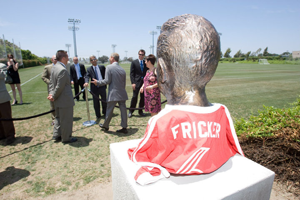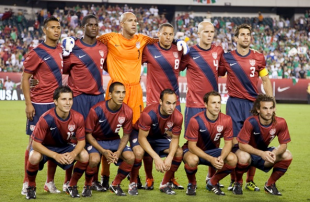Featured photo: Daniel Gajdamowicz
For nearly 150 years, eleven men have been stepping onto a soccer field prepared to attack and defend against their opponent as a unit.
It happens every day all across the world. How often do we think of the significance of the number 11?
The friendly that the United States played against Mexico in Philadelphia on August 10 brought back a historical tradition. In his debut as head coach, Jürgen Klinsmann assigned his eleven starters the numbers 1 through 11. The players on the bench received numbers 12 through 18. This practice is one that dates back to the early days of soccer, but is not often seen in the modern era. The numbering system most national and club teams use today is the “squad numbers” system. This system assigns each individual member of the team a number regardless of whether he was playing or not.
In the days when the starters were given numbers 1-11, the numbers were allotted based on position. Traditionally, shirt numbers were assigned like this: the goalkeeper was assigned number 1, the right full back 2, left full back 3, right half back 4, center half back 5, left half back 6, inside right 7, outside right 8, center forward 9, inside left 10, and outside left 11. Beginning with the 1954 World Cup, squad numbers were introduced with each member of the 22-player roster being assigned a number for the duration of the tournament. Beginning in 1993, England’s FA stopped making making it mandatory for starting line-ups to use the numbers 1-11 and the new practice was soon followed around the world.
 Growing up, my brother and I always knew that our grandpa, Werner Fricker, wore number 6. So, whenever we were being assigned numbers on our youth teams we hoped that we would by some chance be assigned 6. Grandpa was a left halfback, and the captain of United German Hungarians from 1958-1969, leading them in winning the National Amateur Cup in 1965. From 1984 through 1990, he was president of the US Soccer Federation and helped to bring the 1994 World Cup to the US.
Growing up, my brother and I always knew that our grandpa, Werner Fricker, wore number 6. So, whenever we were being assigned numbers on our youth teams we hoped that we would by some chance be assigned 6. Grandpa was a left halfback, and the captain of United German Hungarians from 1958-1969, leading them in winning the National Amateur Cup in 1965. From 1984 through 1990, he was president of the US Soccer Federation and helped to bring the 1994 World Cup to the US.
We hoped to be assigned the number six on our youth teams because we wanted to be like our grandfather. For us it was the closest we would be to knowing a national team player. He part of the US pool from 1963 thru 1967. In 1963 he was the first Philadelphian to play on the US Olympic team since 1956, and was believed to be fourth ever, behind Jack Dunn, Walter Bahr, and Ray Wilson.
Klinsmann’s return to the 11-man numbering system for the USMNT brings back the sense of competition to earn a spot as a starter. We have seen already by the players that have been included on his rosters that not every player or position is guaranteed. Many familiar names have been included, but new ones are also being added.
In addition to the system of numbers, the names of the players have been removed from the backs of the uniforms. While Klinsmann said after the friendly against Mexico that this was because there hadn’t been enough time to include the names, according to US Soccer this practice has the goal “to make sure that everyone is focused on the most important thing on the uniform – the crest representing the United States.”
So, it is the number that labels the player as part of a team. A player has to earn that number, and it becomes a more valued prize.


NICE article…and tribute to your grandpa!!!
Are you related to Helmut Fricker?
Yeah he is my dad’s Onkle!
THE Werner Fricker??? I play on that field almost everyday I’m home in Horsham!!!
Great piece, Michael.
Wonderful Job ,I can tell that your Grandpa was
the inspiration behind this gtreat article.He and I
were friends since we were teenagers.Your Grandpa
earned this praise the hard way,thanks for
the great article.
Frank Junger.
Rugby union holds to that tradition of position-based numbers. I’d like to see soccer all-around go back to that.